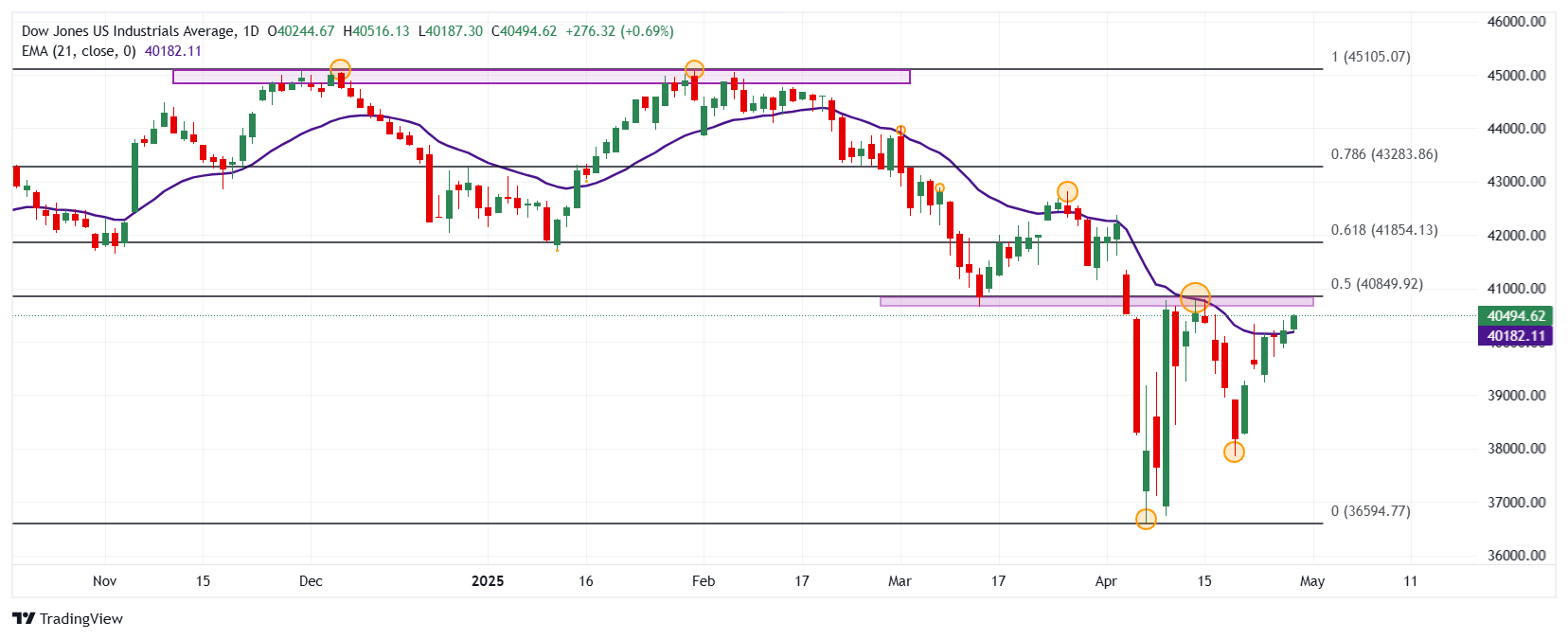- The Dow Jones rises 0.49% in the day, quoting at the time of writing at 40,433.
- The Nasdaq 100 rises 0.25% daily, reaching a maximum of the day in 19,474.
- The S&P 500 advances 0.09% on Tuesday, operating at the moment over 5,529.
- The CB trust index falls to 86 points in April, registering its weakest reading since April 2020.
- The US Jolts employment offers were 7.19 million, below the estimates of analysts.
The Dow Jones established a minimum of the day at 40,187 where he found aggressive buyers that promoted the maximum index of April 16 in 40,461.
The Dow Jones industrial average began operating at 40,244, while the Nasdaq 100 technological index opened in 19,379. The S&P 500 initiated the negotiations in 5,520, taking up the upward perspective in tune with the main share rates.
Honeywell International and Sherwin-Williams Company promote Dow Jones to profit zone
The Dow Jones index rebounds 0.49% daily, reaching a maximum of the day in 40,461.
The titles of Honeywell International (Hon) have a profit of 5.53% on Tuesday, reaching maximum of April 3 in 212.21 $ after the publication of their profits. Hon obtained revenues for $ 9.82 billion compared to 9.59 billion dollars planned by analysts, as well as an action of 2,51 $ compared to the $ 2,209 provided by the market.
In the same tune, Sherwin-Williams Company (SHW) values earn 4.98% daily and reach maximum of April 2 on 351,34 $ after presenting its quarterly report. SHW obtained income for 5.31 billion dollars, slightly below 5.4 billion dollars projected, while gaining a gain per share of $ 2.55 compared to the $ 2,154 estimated by consensus.
The Dow Jones goes up 207 points at the beginning of the American session, signing its sixth consecutive day up.
The Nasdaq 100 operates in positive field animated by Cadence Design Systems
The Nasdaq 100 technological index rises 0.25% in the day, attracting buyers in 19,276 that promoted the index to a maximum of the day in 19,514.
The actions of Cadence Design Systems (CDNS) shoot 4.40% on Tuesday, reaching maximums not seen since February 18 at $ 300.76. CDNS announced its quarterly report in which it obtained 1.24 billion dollars, in line with market estimates, as well as a gain per share of $ 1.57 compared to the $ 1,491 planned by analysts.
On the other hand, Synopsy (SNPS) titles rebound a 2.85% daily, reaching March 26 at $ 457.79.
In this scenario, Nasdaq 100 goes up 54 points, consolidating within the operating range of Monday’s session at 19,464.
The S&P 500 lifts up despite weak economic data from the USA.
The CB consumer trusted index in the United States decreased in April to be located by 86 points, from the 93.9 observed in March, registering its weakest reading since April 2020.
At the same time, the US Jolts employment offers fell to 7.19 million in March compared to the planned 7.5 million, worsening the 7.48 million estimated by analysts.
The S&P 500 rises 15 points today, winning 0.34%, reaching a maximum of the day in 5,547.
Technical Analysis of Dow Jones
The Dow Jones reacted upwards from a short -term support given by the minimum of April 21 in 37,853. To the north, the closest resistance is in 40,774, maximum of April 14. The next key resistance is 42,820, a pivot point of March 26.
Dow Jones daily graphics

Dow Jones Faqs
The Dow Jones Industrial Avenge, one of the oldest stock market indexes in the world, consists of the 30 most negotiated values in the United States. The index is weighted by the price instead of capitalization. It is calculated by adding the prices of the values that compose it and dividing them by a factor, currently 0.152. The index was founded by Charles Dow, also founder of the Wall Street Journal. In recent years it has been criticized for not being sufficiently representative, since it only follows 30 companies, unlike broader rates such as S&P 500.
There are many factors that promote the Dow Jones Industrial Average (DJIA) index. The main one is the added performance of the companies that compose it, revealed in the quarterly reports of business benefits. The American and world macroeconomic data also contribute, since they influence investor confidence. The level of interest rates, set by the Federal Reserve (FED), also influences the DJia, since it affects the cost of credit, on which many companies depend largely. Therefore, inflation can be a determining factor, as well as other parameters that influence the decisions of the Federal Reserve.
Dow’s theory is a method to identify the main trend of the stock market developed by Charles Dow. A key step is to compare the direction of the Dow Jones Industrial Avenge (DJIA) and the Dow Jones Transportation Average (DJTA) and just follow the trends in which both move in the same direction. The volume is a confirmation criterion. The theory uses elements of maximum and minimum analysis. Dow’s theory raises three phases of the trend: accumulation, when intelligent money begins to buy or sell; Public participation, when the general public joins the trend; and distribution, when intelligent money abandons the trend.
There are several ways to operate with the DJ. One of them is to use ETF that allow investors to negotiate the DJ as a single value, instead of having to buy shares of the 30 companies that compose it. An outstanding example is the SPDR Dow Jones Industrial Avenge ETF (day). Future contracts on the DJ allow the specular operators about the future value of the index and the options provide the right, but not the obligation, to buy or sell the index at a predetermined price in the future. Investment funds allow investors to buy a part of a diversified portfolio of DJ values, which provides exposure to global index.
Source: Fx Street
I am Joshua Winder, a senior-level journalist and editor at World Stock Market. I specialize in covering news related to the stock market and economic trends. With more than 8 years of experience in this field, I have become an expert in financial reporting.







